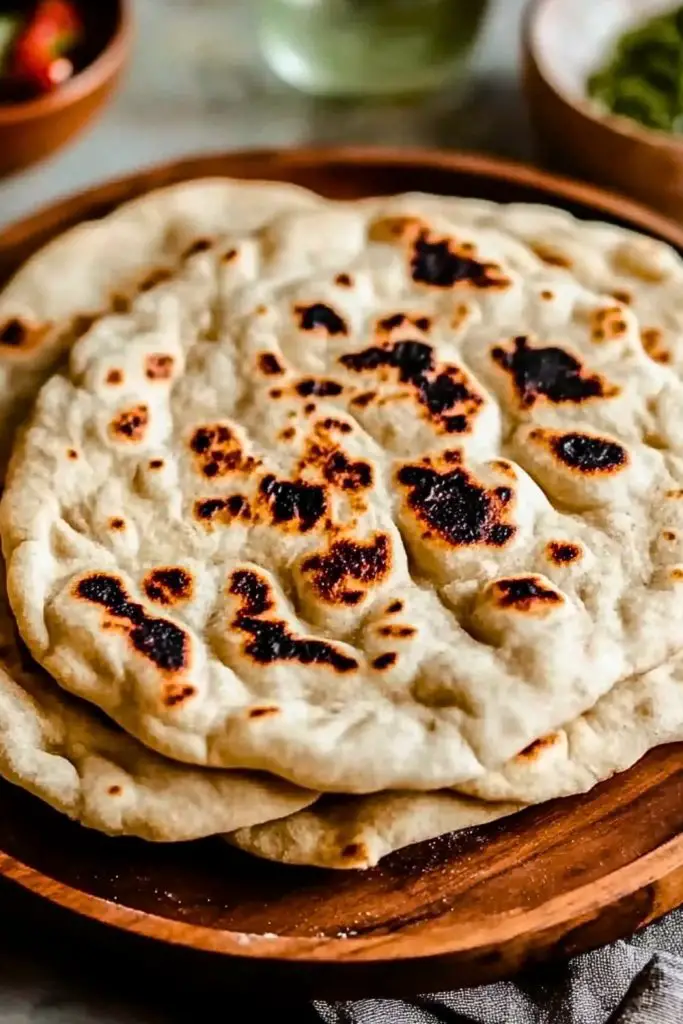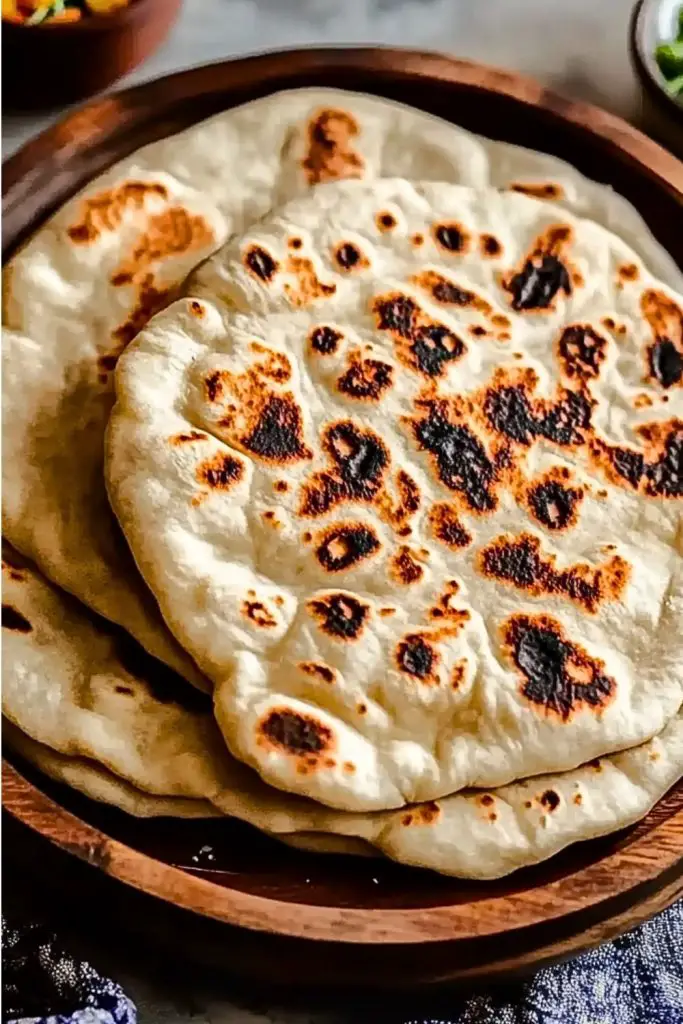Soft, warm, and slightly tangy with just the right amount of chew—Sourdough Naan Flatbread takes your average naan to the next level. Using a sourdough starter adds not only complex flavor but also a beautifully airy texture that pan-frying brings to life with delicious golden blisters and crisp spots. Whether you’re mopping up curry, wrapping grilled meats, or just enjoying it with a dab of butter, this naan feels comforting and indulgent while still being surprisingly simple to make.

Unlike the traditional yeast-leavened versions, this sourdough naan embraces natural fermentation. That means the dough develops flavor slowly, and you end up with a more digestible, probiotic-rich bread. It’s perfect for those who love making the most out of their sourdough starter and want to try something beyond loaves. This flatbread bridges cultures and kitchens—simple in ingredients, yet elevated in flavor.
Why You’ll Love This Sourdough Naan Flatbread
- Naturally leavened: Skip the commercial yeast—this recipe relies on your healthy sourdough starter for a more nuanced flavor.
- Pan-cooked convenience: No need for a tandoor or oven; just a hot skillet brings this naan to perfection.
- Soft and chewy texture: A perfect balance of tenderness and charred bubbles.
- Versatile pairing: Works with Indian dishes, Mediterranean dips, or even as a pizza base.
- Great way to use sourdough discard: Reduce waste while baking something delicious.
- Customizable: Add herbs, garlic, or even cheese for unique variations.
Preparation Phase & Tools to Use
Crafting perfect Sourdough Naan Flatbread begins with understanding the tools and their impact. Each item you use plays a crucial role in the final outcome—fluffy, blistered, and tender naan that rivals any restaurant version.
Essential Tools and Equipment
- Mixing Bowl: Choose a large bowl to comfortably mix and allow the dough to rise. Glass or ceramic retains heat well, supporting fermentation.
- Kitchen Scale: Accuracy is everything in baking. A scale ensures consistent hydration and results every time.
- Cast Iron Skillet or Heavy Pan: To get those signature charred spots and slight crispiness, a heavy-bottomed or cast-iron pan distributes heat evenly and holds it well.
- Rolling Pin: For flattening the dough into uniform discs, a rolling pin is indispensable—aim for about ¼ inch thickness.
- Bench Scraper: Helpful when dividing and handling sticky dough with less mess.
- Clean Towel or Plastic Wrap: Cover the dough during proofing to maintain humidity and prevent skin from forming.
- Measuring Spoons & Cups: For salt, yogurt, and oil, these are essential to keep flavor proportions balanced.
Preparation Tips
- Feed Your Starter in Advance: Make sure your sourdough starter is active and bubbly. Feed it 4–6 hours before mixing the dough if kept at room temperature.
- Rest the Dough Overnight: Letting the dough ferment overnight (8–12 hours) at room temperature gives the best flavor and texture. You can also cold-proof it for a more flexible schedule.
- Use Full-Fat Yogurt: This adds richness and softness to the dough. Greek yogurt works, but plain yogurt offers better hydration.
- Don’t Over-Flour: When rolling, use just enough flour to prevent sticking. Too much can dry out the naan and make it tough.
- Let the Rolled Dough Rest Briefly: Before cooking, let rolled-out naan rest for a few minutes to relax the gluten. This helps prevent shrinking and encourages better puffing.
- Hot Pan = Best Results: Make sure the skillet is very hot before adding the dough. It should sizzle on contact to form those beautiful bubbles and blisters.
- Brush with Ghee or Butter Immediately: Right off the pan, brushing the naan with ghee, butter, or even garlic butter enhances flavor and keeps the naan soft.
Ingredients for This Sourdough Naan Flatbread
This simple yet flavorful recipe uses pantry staples, elevated by the richness of your sourdough starter. These ingredients come together to create a dough that is soft, pliable, and rich in taste, perfect for frying into golden, pillowy flatbreads.
Basic Dough Ingredients
- 240g (1 cup) active sourdough starter
A ripe, bubbly starter at its peak for proper leavening. - 120g (½ cup) plain full-fat yogurt
Adds moisture, tenderness, and a subtle tang. - 30g (2 tablespoons) olive oil or melted ghee
Brings richness and improves the dough’s texture. - 300g (2 ½ cups) all-purpose flour
For structure and chew—bread flour can also be used for extra elasticity. - 1 teaspoon fine sea salt
Balances the flavors and strengthens gluten. - 15–30g (1–2 tablespoons) warm water
Added gradually if needed to adjust the dough’s hydration.
Optional Topping Ingredients
- Melted butter or ghee
For brushing the naan after cooking—adds flavor and keeps it soft. - Fresh minced garlic or garlic powder
Sprinkle just after brushing for garlic naan. - Chopped fresh herbs (like cilantro or parsley)
A colorful, aromatic garnish. - Nigella seeds or sesame seeds
Traditional toppings that add crunch and flavor.

Step-by-Step Instructions for Sourdough Naan Flatbread
Follow this detailed walkthrough to transform your sourdough starter and a few pantry staples into soft, blistered naan bread full of character and flavor.
Step 1: Mix the Dough
In a large mixing bowl, combine:
- 240g active sourdough starter
- 120g plain yogurt
- 30g olive oil or melted ghee
- 300g all-purpose flour
- 1 tsp salt
Mix with a spoon or your hands until a shaggy dough forms. If the dough feels too dry, add 1 tablespoon of warm water at a time (up to 2 tablespoons total) until it becomes soft and slightly tacky.
Step 2: Knead and Bulk Ferment
Knead the dough on a lightly floured surface for 5–8 minutes, or until smooth and elastic. Place it back in the bowl, cover with a damp towel or plastic wrap, and let it ferment at room temperature for 8–12 hours, ideally overnight. It should double in size and become airy.
Step 3: Divide and Rest
Once the dough has risen, turn it out onto a lightly floured surface. Divide it into 6–8 equal pieces depending on how large you want your naan. Shape each into a round ball, cover with a towel, and let rest for 20–30 minutes to relax the gluten—this makes rolling easier.
Step 4: Roll Out the Naan
Take one dough ball and gently roll it into an oval or circle, about ¼ inch thick. Use just enough flour to prevent sticking. Repeat with the rest of the dough balls, stacking them between parchment paper or a floured towel to prevent drying.
Step 5: Cook the Naan
Heat a cast iron skillet or heavy pan over medium-high heat until very hot (it should just begin to smoke slightly). Place one rolled-out piece of dough into the dry pan. Cook for 1–2 minutes, until bubbles form and the bottom is golden with dark spots. Flip and cook another 1–2 minutes on the other side.
Step 6: Finish and Serve
Immediately brush the hot naan with melted butter or ghee. If desired, add toppings like garlic, herbs, or seeds while the naan is still hot. Serve warm and soft, fresh from the pan.
Notes
Sourdough naan flatbread is forgiving and flexible, but a few thoughtful touches can really enhance your results:
- Plan Ahead: Because this is a naturally leavened bread, it requires an overnight ferment. Mix your dough in the evening for fresh naan the next day.
- Room Temperature Flexibility: You can refrigerate the dough for up to 24 hours after the bulk ferment if you’re not ready to cook right away—this actually enhances flavor.
- Don’t Skip the Resting Period: Letting the dough balls rest before rolling makes them easier to shape and prevents tearing.
- Brush Generously: Butter or ghee brushed immediately after cooking locks in softness and adds rich flavor.
- Freeze for Later: Cooked naan freezes beautifully—more on that in Part 7.
Watch Out for These Mistakes While Cooking
Even a simple flatbread like this has a few pitfalls to watch for. Avoiding these will get you restaurant-quality naan at home.
- Using an Inactive Starter: If your starter isn’t bubbly and active, the dough won’t rise well, and your naan may turn out dense.
- Underproofing: If you rush the fermentation, you’ll miss out on flavor and softness. Let it rise fully.
- Over-Flouring While Rolling: Too much flour during rolling can toughen the dough and make the naan dry.
- Cold Pan: A pan that isn’t hot enough won’t form those signature dark bubbles. Always preheat thoroughly.
- Cooking Too Long: Overcooking can make the naan dry and crispy. You’re looking for golden-brown with dark spots, not a full toast.
- Skipping the Butter Brush: That post-cook brush of fat is essential for flavor and softness—don’t skip it!
- Stacking Hot Naan Without Airflow: If you stack them directly from the pan without letting steam escape, they can get soggy. Use a towel-lined basket or rack.
- Adding Garlic Too Early: Garlic burns quickly—always add it after cooking, not before or during.
What to Serve With Sourdough Naan Flatbread
Sourdough naan is as versatile as it is delicious. Its soft interior and lightly charred exterior make it the perfect companion to a wide range of dishes—from saucy curries to crisp salads and savory dips. Whether you’re crafting a full Indian feast or using naan as an appetizer base, this flatbread seamlessly adapts.
8 Recommendations
1. Classic Indian Curries
Think butter chicken, chana masala, or paneer tikka masala. The naan acts as a sponge, soaking up those rich, flavorful gravies.
2. Hummus and Mediterranean Dips
Cut the naan into wedges and serve with hummus, baba ghanoush, or tzatziki for an Eastern Mediterranean platter.
3. Naan Pizza
Top with tomato sauce, cheese, and your favorite toppings. Toast briefly in the oven for a quick, personalized flatbread pizza.
4. Grilled Meats and Kebabs
Pair with lamb koftas, tandoori chicken, or grilled veggies. The naan can be used to wrap the meat, almost like a soft taco.
5. Egg Dishes
Perfect alongside shakshuka, scrambled eggs, or a breakfast wrap. Its chew and flavor make it an ideal breakfast bread.
6. Soups and Stews
Serve as a rustic side to hearty dishes like lentil soup, beef stew, or chicken curry soup. It replaces traditional bread rolls beautifully.
7. Cheese Boards
Add warm naan to a cheese platter with brie, goat cheese, fig jam, and nuts. A soft alternative to crackers or baguette slices.
8. Garlic Naan Snack
Brush with garlic butter, sprinkle with herbs, and enjoy on its own as a snack or appetizer.
Storage Instructions
Sourdough naan flatbread stores well, making it ideal for meal prep or saving leftovers. Whether you plan to keep it for a few days or a few weeks, here’s how to retain its softness and flavor.
Short-Term Storage (1–3 Days)
- Room Temperature: Once fully cooled, wrap the naan in foil or store in an airtight container. Keep at room temperature for up to 3 days.
- Reheating: Warm in a skillet over medium heat for 1–2 minutes per side or wrap in foil and heat in the oven at 300°F (150°C) for 5–10 minutes.
Long-Term Storage (Up to 3 Months)
- Freezing: Stack cooked naan with parchment paper between each piece to prevent sticking, then seal in a freezer-safe bag.
- Reheating from Frozen: Thaw at room temperature, then warm in a skillet, toaster oven, or microwave. To maintain texture, avoid direct microwave-only reheating unless wrapped in a damp paper towel.
Tips to Preserve Freshness
- Avoid refrigerating fresh naan unless necessary; it can dry it out.
- Always cool naan completely before storing to prevent sogginess from trapped steam.
Estimated Nutrition (Per Piece – Based on 8 Servings)
Please note these values are approximate and may vary depending on ingredient brands and exact portion sizes.
- Calories: 190–210 kcal
- Carbohydrates: 28g
- Protein: 5g
- Fat: 6g
- Fiber: 1g
- Sugar: 1g
- Sodium: 180mg
The addition of toppings like garlic butter or cheese will increase both fat and calorie content.
Frequently Asked Questions
1. Can I use sourdough discard instead of active starter?
Yes, you can, but your naan may not rise as much or have the same softness. For best results, use active, bubbly starter. If using discard, consider adding a pinch of baking powder for lift.
2. How long should I ferment the dough?
Ideally, ferment the dough for 8–12 hours at room temperature. This slow proof enhances flavor and texture. A cold ferment (in the fridge) can extend up to 24 hours for more flexibility.
3. Can I make the dough ahead of time?
Absolutely. After bulk fermentation, you can refrigerate the dough for up to 2 days. Just let it come to room temperature before rolling and cooking.
4. What flour works best for sourdough naan?
All-purpose flour gives a soft result, but bread flour offers extra chew. A 50/50 mix of both is a great option too.
5. Do I need a cast iron skillet?
A cast iron pan gives the best texture—those classic bubbles and golden spots. But any heavy-bottomed non-stick or stainless steel pan will work in a pinch.
6. Can I make this dairy-free?
Yes! Replace yogurt with a thick, unsweetened plant-based yogurt (like coconut or cashew), and use olive oil instead of ghee or butter.
7. Why didn’t my naan puff up?
Possible reasons: the pan wasn’t hot enough, dough was rolled too thin or thick, or it was under-proofed. Let the dough fully ferment and rest before rolling for best results.
8. Can I flavor the dough itself?
Yes, feel free to mix in minced garlic, herbs, or spices like cumin or chili flakes directly into the dough for extra flavor.
Conclusion
Sourdough naan flatbread is more than just a side—it’s a flavorful, flexible staple that brings rustic charm to every meal. With the tang of natural fermentation, a soft chewy texture, and the ability to complement everything from Indian curries to Mediterranean dips, this recipe is an excellent way to stretch your sourdough game beyond boules and batards.
Whether you’re serving it fresh off the skillet with butter or freezing a batch for quick dinners, this flatbread delivers every time. It’s approachable, rewarding, and perfect for both beginner sourdough bakers and seasoned pros looking for something new.

Sourdough Naan Flatbread
- Total Time: 30 minutes
- Yield: 6–8 naan breads
Description
Soft, pillowy, and naturally fermented, sourdough naan flatbread is the ultimate fusion of flavor and versatility. This easy recipe uses your sourdough starter to create chewy, bubbly naan that’s perfect for scooping up curries, serving with soups, or turning into flatbread pizzas. With a golden pan-fried surface and a tangy depth from natural fermentation, it’s a must-try for anyone looking for delicious breakfast ideas, easy dinner solutions, or wholesome snack options. Whether you’re meal-prepping or impressing dinner guests, this easy recipe is one you’ll want on repeat.
Ingredients
- 240g (1 cup) active sourdough starter
- 120g (1/2 cup) plain full-fat yogurt
- 30g (2 tbsp) olive oil or melted ghee
- 300g (2 1/2 cups) all-purpose flour
- 1 tsp fine sea salt
- 15–30g (1–2 tbsp) warm water, as needed
Optional Toppings:
- Melted butter or ghee (for brushing)
- Minced garlic or garlic powder
- Chopped fresh herbs (cilantro, parsley)
- Nigella or sesame seeds
Instructions
- In a large mixing bowl, combine sourdough starter, yogurt, oil, flour, and salt. Mix until a shaggy dough forms.
- Add water slowly, only if the dough feels dry. Knead until smooth and elastic (5–8 minutes).
- Cover and ferment at room temperature for 8–12 hours, or overnight.
- After fermentation, divide dough into 6–8 balls. Rest 20–30 minutes under a towel.
- Roll each ball into a 1/4 inch thick oval or circle.
- Heat a cast iron or heavy skillet until very hot. Cook each naan 1–2 minutes per side until golden and blistered.
- Immediately brush with butter or ghee. Add garlic or herbs if using.
- Serve warm, or cool and store for later use.
- Prep Time: 15 minutes
- Cook Time: 15 minutes

